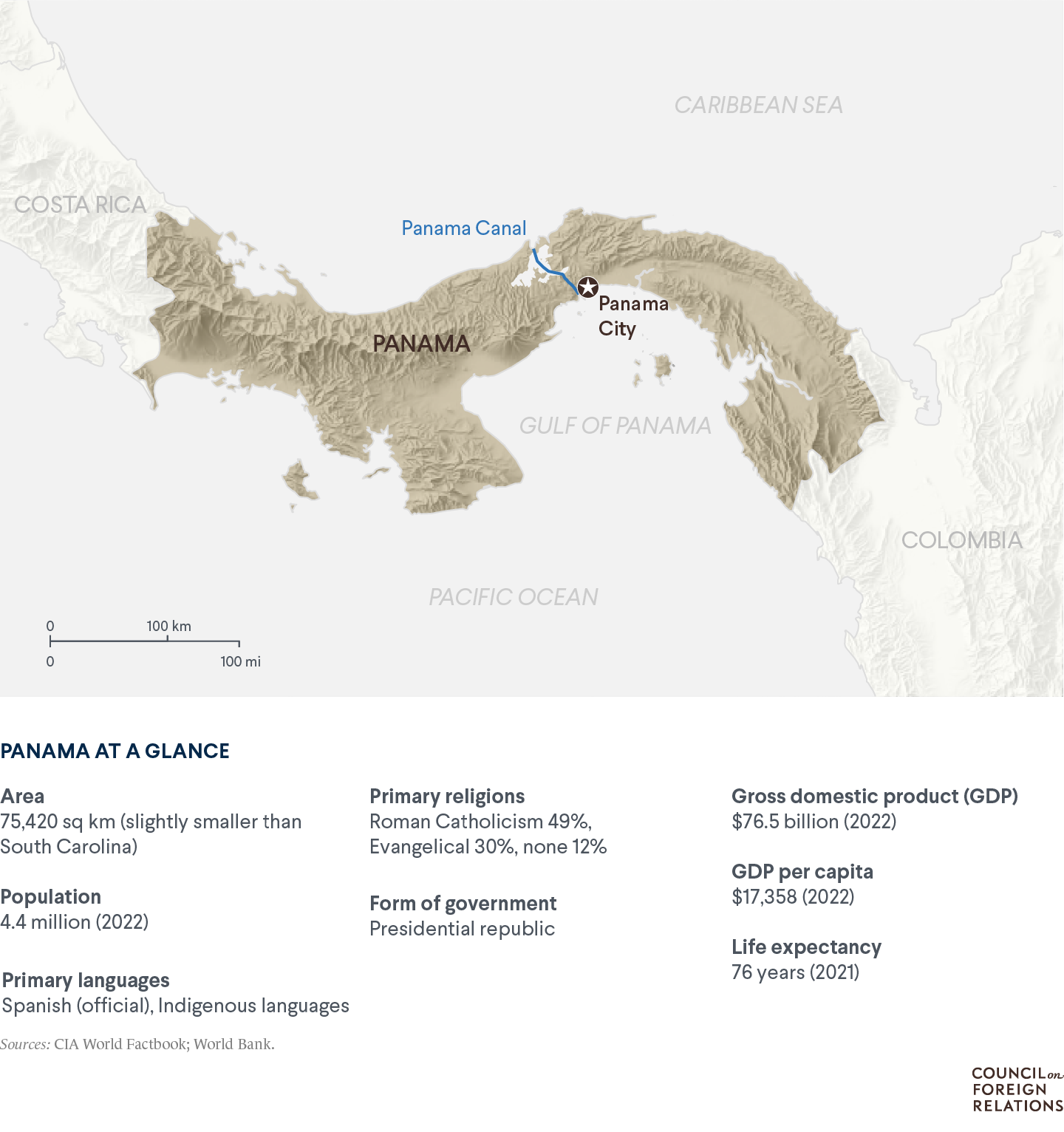In Brief
What’s Causing the Panama Canal Logjam
Low water levels have led to a traffic jam at one of the world’s busiest maritime passages. The bottleneck demonstrates how accelerating climate change is threatening global supply chains.
What’s happening at the Panama Canal?
As of September 28, eighty-nine vessels are waiting to traverse the Panama Canal, which handles hundreds of billions of dollars in global trade each year. The traffic jam has forced ships to endure dayslong wait times and is caused by prolonged drought conditions that have resulted in historically low water levels in the canal.
The canal relies primarily on rainwater from Gatún Lake, a nearby artificial reservoir, to feed its lock system, which uses at least fifty million gallons of water—enough to fill almost seventy-six Olympic-size swimming pools—to float each ship through the canal. Without enough water, the canal can’t operate.
More on:
The Panama Canal Authority (ACP), the government agency that manages the waterway, began imposing water-saving restrictions earlier this year. In addition to capping the number of ships that cross the canal each day, the ACP has restricted their maximum weight and draft, or how deep below the waterline a ship sits. Officials recently extended the measures to last at least ten more months, through late 2024.
![A map showing the location of the Panama canal.]() What does the backlog mean for global supply chains?
What does the backlog mean for global supply chains?
The fifty-one-mile Panama Canal connects the Atlantic and Pacific Oceans and is one of the world’s busiest maritime shipping passageways. Since opening in 1914, the canal has grown to handle about 6 percent of global trade, dramatically reducing the time and cost of shipping by enabling vessels to avoid a lengthy trip around Cape Horn, the southernmost tip of South America. Gatún Lake also supplies drinking water to half the country’s population.
Some thirteen to fourteen thousand ships pass through the canal each year, generating upward of $2 billion in revenue. The United States is the canal’s largest user; 40 percent of all U.S. container ships traverse it annually, carrying $270 billion in cargo. Other major users include Chile, China, Japan, and South Korea.
However, the biggest issue with the logjam concerns energy, with petroleum products being the primary commodities shipped through the canal. As Akron University’s Andrew Thomas told Al Jazeera, “Since the U.S. shale energy revolution with fracking, [the canal] has become the main way energy is moved from the east coast of the United States to China, India, Korea and Japan.” Many companies, such as the Houston-based natural gas company Cheniere Energy, are choosing to forgo the wait and instead sail around Cape Horn, which can add days to a ship’s travel time. Other container ships are using the Panama Canal Railway to move their cargo from the Pacific side to the Atlantic side, where it is reloaded back onto the ships to continue the voyage. The delays have already increased shipping costs and stoked concerns of rising inflation.

More on:
The situation is drawing comparisons to the crisis in Egypt’s Suez Canal in 2021, when a massive container ship ran aground for six days, blocking more than three hundred ships and preventing nearly $10 billion worth of cargo from moving through the canal each day.
What’s the role of climate change?
The impasse highlights the consequences of climate change on global trade and shipping as droughts and other climate disruptions are increasingly challenging crucial supply chains around the world.
Panama is one of the world’s wettest countries; the 75 inches (191 centimeters) of rainfall it receives per year provides plenty of freshwater for Gatún Lake and the canal. But meteorologists say the return of El Niño, a weather pattern characterized by unusually warm ocean temperatures in the Pacific, is making the country drier and hotter. (El Niño occurs every two to seven years on average, though it has become more frequent.) Total rainfall in Panama this year is already at historic lows, experts say, and they warn of even drier conditions next year.
This type of drought, and the resulting shipping restrictions, has happened before. But experts say this year’s situation is especially concerning because it is indicative of a larger climate shift; while drought cycles historically occur once every five years, they are now happening “once every three years,” Canal Administrator Ricaurte Vásquez Morales said.
What could be done?
Canal authorities opened an additional traffic lane in 2016 to accommodate an increasing volume of larger ships that could carry significantly more cargo. However, the additional traffic placed more pressure on the canal’s watershed, and experts say another expansion wouldn’t address today’s water problems. If drought conditions persist, officials could further reduce the number of daily transits beginning in October, threatening to interrupt shipping schedules as the holiday season approaches.
The ACP is also reportedly looking to accelerate a contract with the U.S. Army Corps of Engineers, who built the original canal, to divert four other rivers into the watershed over the next ten years. Other options include constructing a dam on the Indio River to the west of the canal, Vásquez says, or extracting water from Bayano Lake, Panama’s second-largest lake. Regardless, the economic costs are mounting; current shipping restrictions are likely to result in a $200 million drop in revenue next year.
Michael Bricknell made the graphics for this In Brief.
 Online Store
Online Store
 What does the backlog mean for global supply chains?
What does the backlog mean for global supply chains?